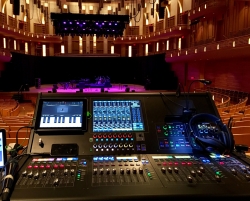Combining forces for the first time, The Manhattan Transfer and Take 6 are out together on the Summit Tour. The tour marks The Manhattan Transfer’s 40th Anniversary of their debut recording on Atlantic Records, while Take 6 has been performing for 36 years now.
To manage 10 voices plus a backup band, front of house mixer Matt Svobodny and monitor mixer Bryan Farina are running a pair of Roland M-5000 OHRCA live mixing consoles.
During the set, Svobodny — who also serves as production manager for the tour — is not only mixing the show for the audience but also handling Take 6’s monitors from the same Roland M-5000 desk. He also has one other critical task: giving the vocalists their pitch cues using a piano app on an iPad that sends the key note to their in-ear monitors.
“It puts some extra pressure on me — I have to be careful and pick my moments as they’re doing their between-song [patter],” he says. “The M-5000 really helps me in that regard. The scenes help limit the number of button pushes I have to do. Also, we have a 40-input show and ten of those as vocals, so I need to keep all of those and some other key things, such as certain effects returns, available on the faders. I can configure the layers in such a way that everything I need is always at my fingertips. On other consoles, I’d be going back and forth between layers to get at what I needed. On the M-5000, I can keep just about the whole show on one layer.”
Monitor engineer Bryan Farina is having a similarly positive experience on his M-5000.
“The latency on the M-5000 is just right for IEMs,” he says, noting that The Manhattan Transfer uses a combination of IEMs in one ear and wedges for monitors, always a tricky combination because of timing differentials. “Also, the M-5000 sounds great, which enables me to focus on fine tuning mixes as opposed to constantly making EQ changes.”
Farina also likes the M-5000’s onboard effects. “I’ve been working with the M-5000 for a while now — I even own one — and it lets me work the way I want to for any situation,” he says. “Take 6 has a pretty sophisticated panning arrangement, and the M-5000 lets me give them what they need quickly and easily. I don’t have to flip faders to get at what I need. It’s all right there.”
The Summit Tour also has a pair of Roland S-2416 digital snake stage units in the system. The S-2416 provides a 24 input x 16 output analog and 8 input x 8 output digital, for a total of 32 input and 24 output channels, all through just a pair of Cat-5 cables.
“Using the REAC ports, I can send a direct out from the front of house console to monitors,” says Svobodny. (The Roland Ethernet Audio Communication protocol enables up to 40×40 channels of audio at 24-bit/96Khz to be transferred across a single Cat5e cable.) “It’s made the system simpler while also making it more reliable.”
In fact, says Svobodny, the Roland products are allowing him and Farina to manage a complex production that might have required twice as many people otherwise.
“We’re just a small crew, but because of systems like the M-5000, we’re able to travel separately in a cargo van and arrive ahead of the artists, letting them get more rest while we set up a sound system that’s very manageable,” he says. “That’s a great thing.”




















